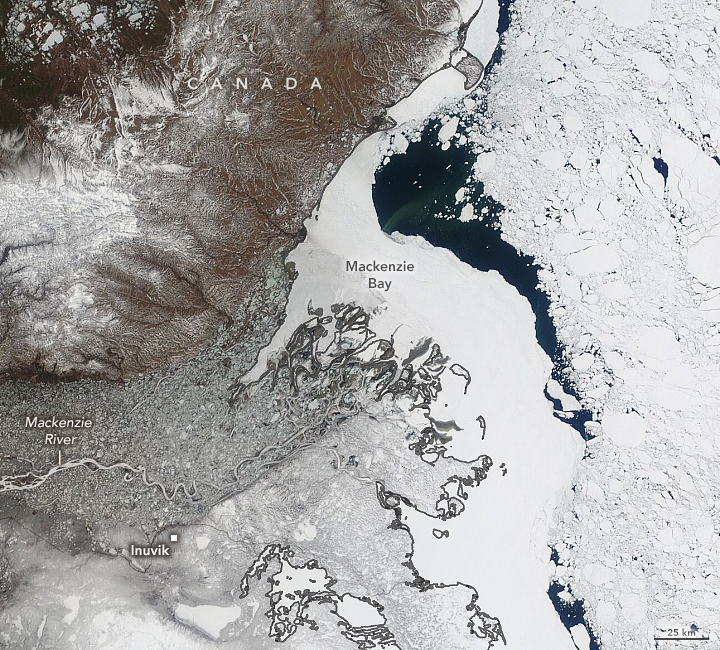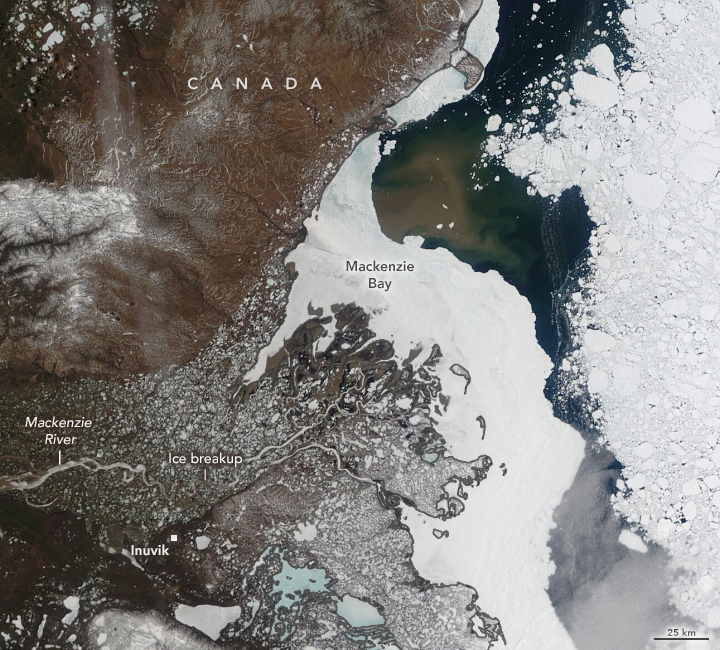Each spring, the Canadian Arctic is the site of a fierce battle between water and ice. The flow of the Mackenzie River, swollen with meltwater, helps break up river ice and pushes north toward the Arctic Ocean. In some places, intact ice resists the pulses of water and spurs flooding. But spring warmth always prevails, and by summer the river flows freely into the Beaufort Sea.
These images, acquired one week apart in May 2020 with the Moderate Resolution Imaging Spectroradiometer (MODIS) on NASA’s Terra satellite, show just how fast the landscape changes at this time of year. In the May 23 image (left), the Mackenzie River and its tributaries are still mostly frozen. By May 30 (right), melt and ice breakup on the river had worked its way north of Inuvik.
The rush of fresh melt water, called a “freshet,” is important for the hydrology of the Mackenzie River Delta because it recharges groundwater and sustains lakes. The river also carries sediments and nutrients—much of it eroded from rocks far upstream in the Rocky Mountains—to the delta plain and coastal ocean. In the images above, some sediment had already made it past the ice into the Beaufort Sea. You can see it just peeking out from the land-fast ice in the May 23 image. It is much more distinct in the May 30 image, coloring the water with a muddy brown plume.
The land-fast ice visible was still acting like a barrier as late as May 30. But when it eventually gives way, it will release a large pulse of warm water into the Arctic Ocean. Previous research has shown this early summer pulse can raise offshore water temperatures across hundreds of kilometers, helping to melt and disperse nearby sea ice. The effect on sea ice becomes more important as the global climate warms and larger volumes of warm freshwater are discharged.
More immediately, with the ice barrier still intact and ice jams still clogging rivers, numerous riverside communities have been on alert for flooding. On June 1, the Mackenzie River’s East Channel near the town of Inuvik rose to 16.5 meters—the highest water level on record for that location. According to news reports, some people in the town were evacuated from their cabins.
NASA Earth Observatory images by Lauren Dauphin, using Landsat data from the U.S. Geological Survey. Story by Kathryn Hansen.
"along" - Google News
June 08, 2020 at 05:06AM
https://ift.tt/3cGBcX6
Breakup Along the Mackenzie River - NASA
"along" - Google News
https://ift.tt/2z4LAdj
https://ift.tt/35rGyU8
Bagikan Berita Ini

















0 Response to "Breakup Along the Mackenzie River - NASA"
Post a Comment